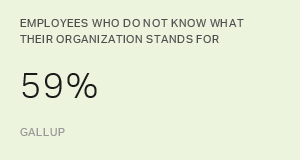Story Highlights
- Employees don't respond well to top-down change management
- You should include the whole organization in visioning for the future
- Employees will get behind a vision that they co-created
It is when problems seem insurmountable that leaders most need a positive vision.
As Dee Hock, founder and former CEO of Visa, once said, "It is far too late and things are far too bad for pessimism." In other words, no matter how good or how bad things get, it is always the right time to focus on your organization's strengths.
For all the resources companies spend on communication, Gallup's research shows that 59% of employees cannot strongly agree that they know what their organization stands for.
One reason for this failure is the widespread use of mechanistic models of change that emphasize centralized control, routine behavior and predictable outcomes. While such models are appropriate in stable environments, they are ill-suited to turbulent environments -- precisely the kinds of VUCA (Volatile, Uncertain, Complex and Ambiguous) environments that most organizations find themselves in today.
The rise of millennials in the workplace is also a factor: 75% of the global working population will be comprised of millennials by 2025.
Millennials value collaboration, resourcefulness and transparency. And yet, all too often, vision creation and the ensuing communication tend to be a one-way street.
Change arrives as a top-driven mandate that is "cascaded" down as a series of guidelines, directives and rules. It's no wonder then that millennials feel uninspired and unmotivated by traditional change management.
The solution is to include everyone in the process of change not just the notification of change -- and to lead change toward a positive future, rather than merely avoiding a negative one.
An Intentional Inquiry Into the Positive
Recent behavioral research has shown that when groups focus on solving problems, they become depressed, but when they formulate plans by working backward from what they want to create, they develop energy, enthusiasm, optimism and high commitment.
And yet, in general, most people, teams and organizations find it very difficult to explain their own success but are very good at obsessively explaining, analyzing and documenting their failures.
At Gallup, our work on organizational change is based on the positive change principle -- which focuses on what's working well and what a positive, energizing vision of the future could look like rather than focusing solely on problems, issues and obstacles.
A process like this typically involves including a large section of the organization in evoking visions, images and dreams of what is possible. This is the first step to move the dialogue from that of deficits ("what's going wrong") to strengths ("what needs to happen" and "what should happen to support our vision").
For example, a Gallup client that wanted to create a new purpose statement had their leaders conduct a series of interviews with employees, customers and peers before the purpose workshop. Questions that were asked in these interviews were affirmative -- focused on what has worked and imagining a future where more of what has worked in the past could be repeated and emphasized.
Gallup consultants synthesized this information, and it led to a purpose statement that was positive, energizing and action-oriented.
How to Jump-Start Positive Change
A range of large group change methods, such as Appreciative Inquiry, focus on this aspect of defining what needs to change by imagining the future.
However, the positive change approach is not a way of spinning communication to sound positive when it really is not. It is a philosophical approach to change that involves every aspect of the process.
Beyond having a "what's working" mindset, here are a few additional considerations:
-
Separate problem-solving mode and visioning mode.
Both visioning and problem-solving are integral parts of enterprise-level action planning for change. However, they are quite different approaches that should be used in sequence -- i.e., visioning followed by planning.
Organizations make a mistake when they combine the problem-solving mindset with the inspirational creative mode.
-
Pay attention to words.
The language used in the process of defining change and the vision is critical. When we define change as problems, we find more problems. However, if we define change as the pursuit of new ideas, new dreams and visions, the focus is on how we can make change happen.
As part of the visioning process, listen closely to how the change is being talked about -- the words, metaphors and stories used. Use of negative language and metaphors can lead to unnecessary fear and unwarranted confusion about the nature and scope of the change.
-
Allow co-creation to generate change advocates.
Recent studies have shown that we are more likely to reach an objective if we can see it and can imagine the steps it takes to reach it.
True visioning is not about creating slogans, jargon and catchphrases but allowing people the opportunity to co-create vision, mission and values, which generates greater ownership in the final vision.
Leaders spend tremendous energy driving change -- from roadshows to town halls, digital tools to team sessions. And yet, according to a McKinsey survey, less than 30% of change efforts are successful.
Isn't it time to take a different approach?
Gallup can help you create organizational change that sticks -- through a positive approach:
- Download the How Millennials Want to Work and Live report to learn what millennials expect from an employer.
- Use CliftonStrengths in your organization to help your employees do what they do best, every day.
- Work with us to design a new vision for your organizational culture.
Ryan Pendell contributed to this article.

